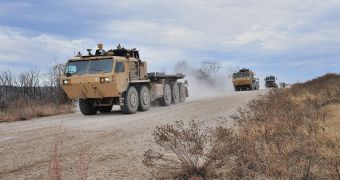Engineers at Lockheed Martin, working with scientists at the US Army Tank-Automotive Research, Development and Engineering Center (TARDEC) have recently demonstrated that existing military trucks can be outfitted with a robotics system that allows the vehicles to drive themselves.
This effort is part of a larger Army plan to reduce the size of its brigades, from 4,000 to 3,000 soldiers, and replacing non-combat personnel and equipment with robots. This does not mean that front line soldiers will be replaced by robots with guns. However, parts of the logistics and support chains may be automated, officials say.
The newly developed system could soon enable the Army to deploy fully autonomous convoys to the battlefield and adjacent areas. This research successfully demonstrated that trucks of various makes and models can be turned into autonomous, self-driving vehicles.
A series of test drives demonstrating the new system were carried out in January at the Fort Hood installation in Texas, as part of the US Army and US Marine Corps’ Autonomous Mobility Appliqué System (AMAS) program.
The driverless vehicles proved that they could easily navigate obstacles and other hazards, as well as complex urban environment. The autonomous system is able to detect pedestrians crossing the street, as well as incoming traffic, thus minimizing the risk of accidents.
“The AMAS CAD hardware and software performed exactly as designed, and dealt successfully with all of the real-world obstacles that a real-world convoy would encounter,” announced the AMAS program manager for Lockheed Martin Missiles and Fire Control, David Simon.
“It was very important that we had representation from the technology, acquisition and user bases, along with our industry partners, here at the [Capabilities Advancement Demonstration],” added Bernard Theisen, a technical manager at TARDEC.
“We are very pleased with the results of the demonstration, because it adds substantial weight to the Army’s determination to get robotic systems into the hands of the warfighter,” he concluded, quoted by IEEE Spectrum.

 14 DAY TRIAL //
14 DAY TRIAL //